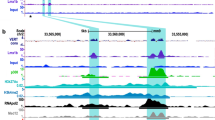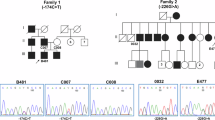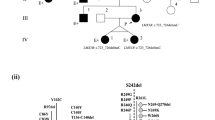Abstract
Nail patella syndrome (NPS) is an autosomal dominant disorder affecting development of the limb, kidney and eye. NPS is the result of heterozygous loss-of-function mutations in the LIM-homeodomain transcription factor, LMX1B. Recent studies suggest that the NPS phenotype may be more extensive than recognized previously including neurologic and neurobehavioral aspects. To determine whether these findings correlated with the expression of Lmx1b during development, an internal ribosomal entry site-LacZ reporter was inserted into the 3′UTR of the endogenous murine gene. The pattern of Lmx1b expression during the development of the limb, eye and kidney correlates with the NPS phenotype. Additional sites of expression were observed in the central nervous system (CNS). The effects of the absence of Lmx1b in the CNS were determined in lmx1b−/− mice by histology and immunocytochemistry. Lmx1b is required for the differentiation and migration of neurons within the dorsal spinal cord. The inability of afferent sensory neurons to migrate into the dorsal horn is entirely consistent with diminished pain responses in NPS patients.
Similar content being viewed by others
Log in or create a free account to read this content
Gain free access to this article, as well as selected content from this journal and more on nature.com
or
References
Carbonara P, Alpert M : Hereditary osteo-onycho-dysplasia (HOOD). Am J Med Sci 1964; 248: 139–151.
Bongers EM, Gubler MC, Knoers NV : Nail-patella syndrome. Overview on clinical and molecular findings. Pediatr Nephrol. 2002; 17: 703–712.
Sweeney E, Fryer A, Mountford R, Green A, McIntosh I : Nail patella syndrome: a review of the phenotype aided by developmental biology. J Med Genet 2003; 40: 153–162.
Bodziak KA, Hammond WS, Molitoris BA : Inherited diseases of the glomerluar basement membrane. Am J Kid Dis 1994; 23: 605–618.
Lichter PR, Richards JE, Downs CA, Stringham HM, Boehnke M, Farley FA : Cosegregation of open-angle glaucoma and the nail-patella syndrome. Am J Ophthalmol 1997; 124: 506–515.
Chen H, Lun Y, Ovchimnikov D et al: Limb and kidney defects in Lmx1b mice suggest an involvement of LMX1B in human nail-patella syndrome. Nat Genet 1998; 19: 51–55.
Dreyer SD, Zhou G, Baldini A et al: Mutations in LMX1B cause abnormal skeletal patterning and renal dysplasia in nail patella syndrome. Nat. Genet 1998; 19: 47–50.
Dunston JA, Hamlington JD, Zaveri J et al: The human LMX1B gene: transcription unit, promoter and pathogenic mutations. Genomics 2004; 84: 565–576.
Dawid IB, Toyama R, Taira M : LIM domain proteins. C R Acad Sci III 1995; 318: 295–306.
Curtiss J, Heilig JS : DeLIMiting development. Bioessays 1998; 20: 58–69.
Gross MK, Dottori M, Goulding M : Lbx1 specifies somatosensory association interneurons in the dorsal spinal cord. Neuron 2002; 34: 535–549.
Muller T, Brohmann H, Pierani A et al: The homeodomain factor lbx1 distinguishes two major programs of neuronal differentiation in the dorsal spinal cord. Neuron 2002; 34: 551–562.
Bi W, Deng JM, Zhang Z, Behringer RR, de Crombrugghe B : Sox9 is required for cartilage formation. Nat Genet 1999; 22: 85–89.
Nonchev SG, Maconochie MK : Spatial analysis of gene expression; in Jackson IJ, Abbott CM (eds): Mouse Genetics and Transgenics: A Practical Approach. Oxford: Oxford University Press, 2000, pp 61–86.
Chen ZF, Paquette AJ, Anderson DJ : NRSF/REST is required in vivo for expression of multiple neuronal target genes during embryogenesis. Nat Genet 1998; 20: 136–142.
Chen ZF, Rebelo S, White F et al: The paired homeodomain protein DRG11 is required for the projection of cutaneous sensory afferent fibers to the dorsal spinal cord. Neuron 2001; 31: 59–73.
Chen H, Ovchinnikov D, Pressman CL, Aulehla A, Lun Y, Johnson RL : Multiple calvarial defects in lmx1b mutant mice. Dev Genet 1998; 22: 314–320.
Ding YQ, Kania A, Johnson RL, Chen ZF : Lmx1b controls the differentiation and migration of the superficial dorsal horn neurons of the spinal cord. Development 2004; 131: 3693–3703.
Smidt MP, Asbreuk CH, Cox JJ, Chen H, Johnson RL, Burbach JP : A second independent pathway for development of mesencephalic dopaminergic neurons requires Lmx1b. Nat Neurosci 2000; 3: 337–341.
McIntosh I, Tierny E, Bukelis I, Marsh L : Behavioral phenotype of nail-patella syndrome. Am J Hum Genet 2001; 69S: A571.
Snider WD, McMahon SB : Tackling pain at the source: new ideas about nociceptors. Neuron 1998; 20: 629–632.
Goetz CG, Pappert EJ (eds): Textbook of Clinical Neurology. Philadelphia, PA: WB Saunders, 1999, 1st edn, pp 315–349.
Agostino R, Cruccu G, Iannetti G, Romaniello A, Truini A, Manfredi M : Topographical distribution of pinprick and warmth thresholds to CO2 laser stimulation on the human skin. Neurosci Lett 2000; 285: 115–118.
Acknowledgements
We would like to thank Drs Andrew McCallion and Julie Hoover-Fong for helpful discussion and critical review of the manuscript, and Dr Lori E. Kotch for helpful discussions and access to microscopes. This work was supported in part by NIH Grants AR44702 (IM), EY12311 (RLJ) and NS43968 (ZFC), and grants from the Birth Defects Foundation and the Skeletal Dysplasia Group (ES).
Author information
Authors and Affiliations
Corresponding author
Rights and permissions
About this article
Cite this article
Dunston, J., Reimschisel, T., Ding, YQ. et al. A neurological phenotype in nail patella syndrome (NPS) patients illuminated by studies of murine Lmx1b expression. Eur J Hum Genet 13, 330–335 (2005). https://doi.org/10.1038/sj.ejhg.5201332
Received:
Revised:
Accepted:
Published:
Issue date:
DOI: https://doi.org/10.1038/sj.ejhg.5201332
Keywords
This article is cited by
-
The first presentation of a case of nail-patella syndrome newly diagnosed at the onset of rheumatoid arthritis: a case report
BMC Musculoskeletal Disorders (2024)
-
Interaction of the LMX1B and PAX2 gene products suggests possible molecular basis of differential phenotypes in Nail–Patella syndrome
European Journal of Human Genetics (2005)
-
Genotype–phenotype studies in nail-patella syndrome show that LMX1B mutation location is involved in the risk of developing nephropathy
European Journal of Human Genetics (2005)



